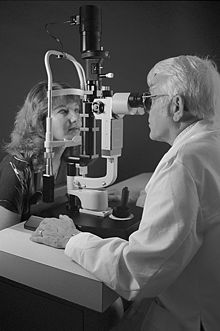Exploring the Newest Technical Improvements in Optometry and What They Mean for Optometrists
In the ever-evolving field of optometry, recent technological advancements are reshaping exactly how professionals come close to eye treatment. From the precision of Optical Coherence Tomography to the nuanced insights offered by AI-driven diagnostic tools, these technologies are setting new standards in client analysis and therapy. Teleoptometry is poised to redefine accessibility, making sure that know-how transcends geographical restrictions. As these improvements penetrate the technique, eye doctors are confronted with the obstacle of welcoming these tools to enhance client results. Yet, the concern stays: exactly how will these technical shifts redefine the duties and responsibilities within the profession?
Innovations in Diagnostic Tools
Advancing the field of optometry, innovations in analysis devices have revolutionized the means eye treatment specialists analyze and detect aesthetic problems and eye conditions. The previous decade has witnessed substantial technological innovations, making it possible for even more precise and detailed examinations.
Another secret innovation is the introduction of sophisticated corneal topography systems, which map the surface curvature of the cornea with accuracy. These tools are specifically beneficial for suitable get in touch with lenses and diagnosing corneal disorders. Digital retinal imaging has actually changed standard ophthalmoscopy, offering comprehensive, breathtaking views of the retina that assist in thorough visual assessments.
The development of wavefront aberrometry has additionally been crucial, allowing the analysis of refractive errors with unequaled precision (Eye Doctor Optometrist). This technology helps in tailoring rehabilitative lenses and enhancing surgical outcomes for refractive surgical procedures. Jointly, these analysis innovations encourage eye doctors to supply remarkable individual treatment, making sure very early treatment and customized treatment techniques, eventually enhancing visual health and wellness end results
AI in Person Monitoring
Building on the structure of innovative diagnostic tools, the incorporation of fabricated intelligence (AI) in patient management stands for a transformative leap for optometry. AI systems are progressively employed to boost effectiveness, precision, and customization in client treatment.
In addition, AI-driven systems promote structured patient communications and administrative procedures. Automated scheduling, online assessments, and personalized follow-up strategies not just enhance person satisfaction but likewise maximize time management for experts. These systems can triage patients based upon the seriousness of their problems, ensuring that those in essential requirement obtain punctual interest.
Additionally, AI improves decision-making by giving optometrists with evidence-based suggestions and therapy pathways. By integrating data from digital health and wellness documents, AI devices offer understandings that educate scientific choices, reducing the danger of mistakes and enhancing patient end results. As AI proceeds to progress, its duty in patient management will likely broaden, reshaping the landscape of optometric treatment.
Breakthroughs in Retinal Imaging
In the realm of optometry, retinal imaging has witnessed remarkable technical advancements that are improving diagnostic capacities and person care. Innovations such as Optical Comprehensibility Tomography (OCT) and fundus digital photography have revolutionized how eye doctors examine the retina and imagine.
Boosted imaging techniques like OCT angiography are more refining diagnostic accuracy. Opticore Optometry. Such developments promote the identification of minute retinal modifications that can represent disease progression.
Additionally, innovations in expert system are increasing retinal imaging by enabling automated evaluation of huge datasets. These systems assist optometrists in determining patterns a measure of pathology, therefore improving analysis precision and performance. Jointly, these innovations have a peek at this site are transforming retinal imaging into a foundation of contemporary eye treatment, improving outcomes and expanding therapeutic opportunities.
Teleoptometry's Expanding Duty
Teleoptometry is significantly coming to be an essential component of eye care, driven by improvements in digital communication and diagnostic tools. This is especially valuable in underserved and rural areas where access to specialized eye treatment is typically limited.
The combination of expert system (AI) further boosts teleoptometry, allowing the evaluation of visual information and assisting in the discovery of ocular conditions such as glaucoma and diabetic retinopathy. AI-powered formulas can quickly interpret complicated imaging information, offering optometrists with important insights that boost clinical decision-making.
Furthermore, teleoptometry sustains connection of treatment through seamless combination with electronic health and wellness records (EHRs), permitting optometrists to maintain detailed client backgrounds. This guarantees that patients get customized and regular treatment also when consulting with various experts.
In spite of these benefits, challenges stay, including ensuring information safety and taking care of individual assumptions. Teleoptometry stands for a significant stride in the direction of even more obtainable, effective, and patient-centered eye care. As innovation advances, its duty is positioned to broaden better.

Future Trends in Eye Treatment
A myriad of cutting-edge fads is readied to improve the future of eye care, driven by technological advancements and the evolving needs of clients. One substantial pattern is the combination of expert system (AI) in diagnostics, which assures to enhance the precision and effectiveness of eye examinations. AI formulas can assess huge amounts of data from retinal images, possibly identifying problems like diabetic retinopathy and glaucoma earlier than conventional methods.
Moreover, personalized medication is getting traction in optometry, with hereditary screening educating tailored therapy plans. This strategy aims to enhance client end results by tailoring treatments to private genetic accounts. Wearable modern technology, such as wise contact lenses, is also imminent, using real-time monitoring of intraocular stress or glucose degrees, therefore providing continuous understandings into systemic and ocular wellness.
The fostering of enhanced fact see post (AR) and online fact (VR) in training and patient education and learning is another arising fad. These modern technologies provide immersive experiences that can boost understanding and skills both for patients and eye doctors. As these fads advance, eye doctors must stay abreast of technological developments to supply sophisticated treatment, making sure improved client end results and satisfaction in the vibrant landscape of eye care.
Verdict

Collectively, these analysis advancements encourage optometrists to deliver remarkable client care, ensuring very early intervention and customized therapy techniques, ultimately enhancing aesthetic health end results.

As these innovations proceed to evolve, optometrists have to adapt and include them into practice, eventually maximizing workflow performance and raising the standard of eye treatment delivered to individuals.